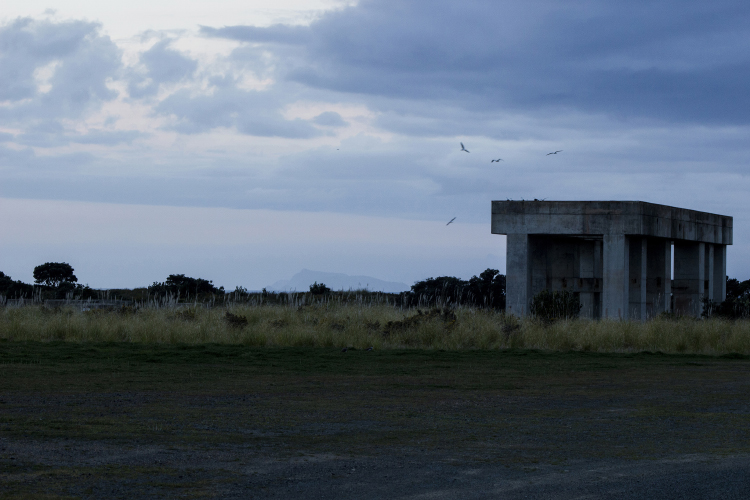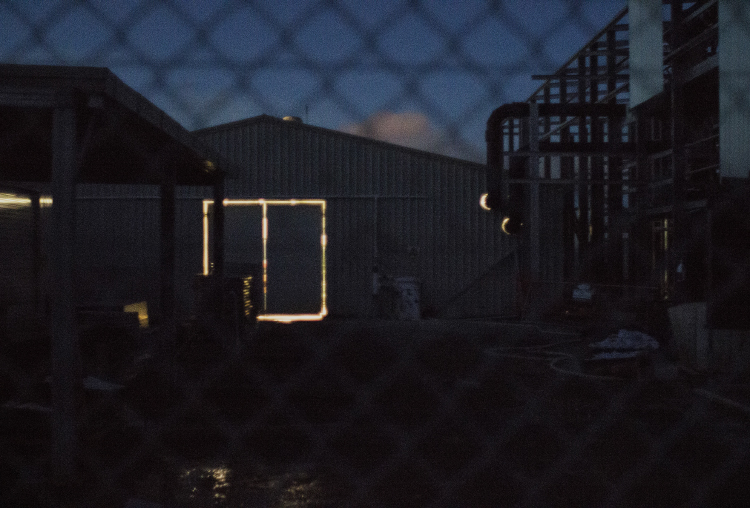Portrait of Place
Clare Slako’s Ruakaka
CATHY TUATO’O ROSS

CLARE SLAKO Marsden Power Station 2017 Digital photograph
Karawai Street, Ruakaka, could have been the setting for a New Zealand adaptation of Edward Scissorhands. The low brick bungalows, set in close proximity to the street and to each other, have knee-high fences that offer no privacy, shelter nor containment. There are no large dogs, secretive smokers or hidden gardens; instead the grid of development is displayed, while a nod is given to the notion of friendly community. There is a bit of an ‘everystreet’ feel to the place, which shares something of the appearance and social intentions of the garden suburb designs of the 1930s and ’40s state housing schemes. Nevertheless, Karawai Street is not a well-preserved suburb of quality mid-century social housing.
The Marsden Power Station Village was constructed in the 1960s. Here streets are wide and empty, and there is a large concrete court and hoop inviting the youth to come out to play. A church ‘kiosk’, which shares resemblances with both public restrooms and small rural train stations, looked over the court with Play School windows. Once the property of the Anglican Church (that still has a large and well- maintained centre of worship on the adjoining lot), the kiosk and court are reminders of the role religion played in the story of colonial New Zealand. Photographed by Clare Slako in 2016, the pale lemon building has subsequently been removed and the court and surrounding land now appear in the Trade Me property listings as a ‘once in a lifetime opportunity . . . build your forever home here and enjoy the coastal paradise you’ve dreamed of’.
The coastal paradise of Ruakaka has also been described as an industrial hinterland. While the beach boasts white sand, enviable surf and plentiful rewards for recreational fishers, the district is also home to the Marsden Point Oil Refinery, a timber processing plant, Northland’s main port, NIWA’s Bream Bay Aquaculture Park and the Ruakaka Racecourse. The industries provide employment locally and are of strategic importance to regional and national infrastructure. There seems to be a pragmatic relationship between people and place. If you look right along the beach you do not see the dirty red and white refinery incinerator chimneys, but you can still catch a waft of fuel if the wind changes.
The Marsden Power Station Village was built to house workers at the Marsden A and B Power Station, projects of the Think Big era that were mothballed without ever being fired up. The true scale of the folly is no longer on show as Marsden B was sold, dismantled, then shipped to India. What remains are large tracts of seemingly forgotten land which function as unlikely sculpture parks for monumental concrete remnants. Electricity lines and pylons still lace over the land, as power generated elsewhere is managed here by the Marsden substation. Slako quietly acknowledges the heyday that never happened in her photographic documents of this place. Ruakaka, her home and a place that she loves, continues as a site of simultaneous development and abandonment.

CLARE SLAKO Fly Tipping 2016 Digital photograph

CLARE SLAKO Church Kiosk 2017 Digital photograph

CLARE SLAKO NIWA 2016 Digital photograph

CLARE SLAKO Misty Morning at GAS Ruakaka 2017 Digital photograph
